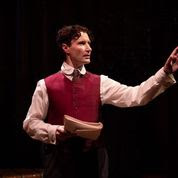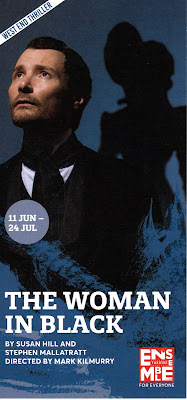The Woman in Black by Susan Hill and Stephen Mallatratt. Ensemble Theatre, Sydney, June 11 – July 24, 2021.
Reviewed by Frank McKone
June 16 Opening Night
Cast
The Actor Garth Holcombe
Mr Kipps Jamie Oxenbould
Creatives
Director Mark Kilmurry
Assistant Director Rachel Chant
Set & Costume Designer Hugh O’Connor
Lighting Designer Trudy Dalgleish
Sound Designer Michael Waters
Stage Manager Ruth Hollows
Assistant Stage Manager Jack Wilson
Costume Supervisor Margaret Gill
Special Effects Bronte Bailey
Assistant Sound Designer David Grigg
You will surely cling tight to your partner as the LNER (London North Eastern Railway) Express flashes and roars past, blasting your local train carriage with terrifying sound and light, as you approach the small market town of Crythin Gifford to attend the funeral of a client, Mrs Alice Drablow. Is it she who appears, or rather disappears, in the shadows of the graveyard? Is her house, isolated among foggy swamps and the notoriously freezing easterly winds of the Broads, truly haunted?
This is a very English play, in a fearfully good presentation in the boatshed, with its feet in the water, which is The Ensemble – hardly more capacious than that local train compartment. Never a dull moment in its two-hour traffic on the stage, even in the silences when your mind races to guess what may or may not be real. Garth Holcombe and Jamie Oxenbould never miss a heart-beat in this expertly designed drama of sound and light.
Yet, despite The Woman in Black (1987) being the second-longest-running West End non-musical show after The Mousetrap, as theatre art goes the play-script doesn’t compare with the first play of its kind, when, in 1921 the audience “split into supporters and adversaries. The author, who was present at the presentation with his daughter Lietta, was forced to leave the theatre through a side exit in order to avoid the crowd of opponents.” That was Luigi Pirandello’s Six Characters in Search of an Author which ends with the death of a young boy backstage, leaving the audience believing it had really happened.
[ https://en.wikipedia.org/wiki/Six_Characters_in_Search_of_an_Author ]
Long before that “Leoncavallo wrote that he based the story of [his opera] Pagliacci on an incident from his childhood: a murder in 1865, the victim of which was a Leoncavallo family servant, Gaetano Scavello. The murderer was Gaetano D'Alessandro, whose brother Luigi was his accomplice. The incident resulted from a series of perceived romantic entanglements involving Scavello, Luigi D'Alessandro, and a village girl with whom both men were infatuated. Leoncavallo's father, a judge, was the presiding magistrate over the criminal investigation.” [ https://en.wikipedia.org/wiki/Pagliacci ]
In
the opera, where the singers we see are commedia dell’arte actors in
the Harlequin story, the stabbing and death for real of Nedda, playing
the part of Colombina, by her acting partner, Canio, playing the role of
the clown Paliaccio, is horrifying to watch – even more so when Silvio,
who was playing Arlecchino, is also killed by Canio. The clown had, in
jealousy, mistakenly thought the words of Colombina to Arlecchino "I
will always be yours!" are truly the words of his wife Nedda to his
rival Silvio.
All three plays mess up our heads about acting and
reality; at a deeper level about belief and truth; and even at a
political level about fake news and honesty. The Woman in Black is relatively simple plot-wise, and the ending is too predictable – a fictional device – compared with the complexity of the Six Characters from an unknown play invading another company’s rehearsal of a known play, (Mixing it Up
by Luigi Pirandello!). It becomes impossible to distinguish between
the roles actors are playing, in the play within the play within the
play we are watching, and the possibility that they are not acting but
are in real conflict, leading to actual death.
The success, in the end, of The Woman in Black
relies upon the technical quality of the production. We know we are
watching a performance, yet we still are genuinely frightened as we hear
ghostly sounds and see for ourselves a woman in black whose name is not
revealed in the program. And, to be fair, we feel afraid along with
The Actor that his young son may die just as did Mr Kipps’ boy. We do
not know what will happen, but we can imagine how we would feel if it did; even more if it happened to us.
So
this ghost story is not about making you believe in ghosts: but it’s
certainly about our fear of the uncertainty of life. Ensemble Theatre,
with great directing, top quality acting and terrific (terrifying) sound
and light design succeed perhaps better, I suggest, in this small
theatre-in-the-round – where we become like Mr Kipps’ family having this
Actor act out Mr Kipps’ scary story for us – than it would in a large
conventional theatre.
It is a tour de force for just two
actors (not counting the mystery woman) over two intense hours,
constantly changing from being in and out of fictional roles in Mr
Kipps’ play while switching into and out of their roles as Actor and Mr
Kipps in Susan Hill’s story as developed by Stephen Mallatratt.
Some stills by Daniel Boud help to show how the play works:
 |
| Garth Holcombe as The Actor and Jamie Oxenbould as Mr Kipps |
 |
| Garth Holcombe as The Actor directing Mr Kipps who says he is not an actor, how to act. |
 |
| Jamie Oxenbould playing as Mr Kipps acting as Mr Daily from the town of Crythin Gifford in Mr Kipps' playscript. |
 |
| Garth Holcombe playing The Actor acting as Mr Kipps in the house of his client, Mrs Alice Drablow in Mr Kipps' playscript |
There is, of course, no photo of the woman in black.
"La commedia è finita!!" – or in this case, the mystery is ended – or is it?
© Frank McKone, Canberra


No comments:
Post a Comment